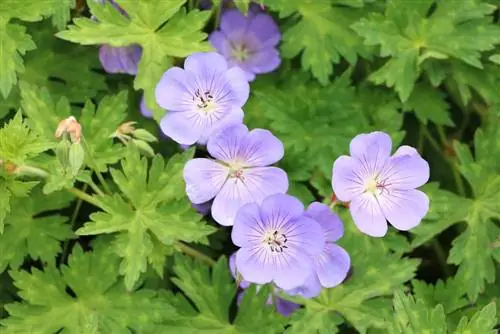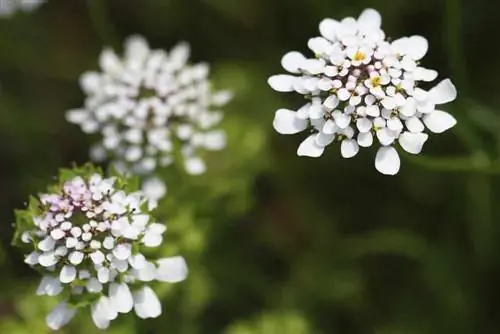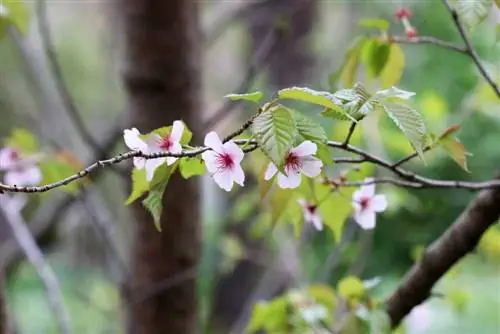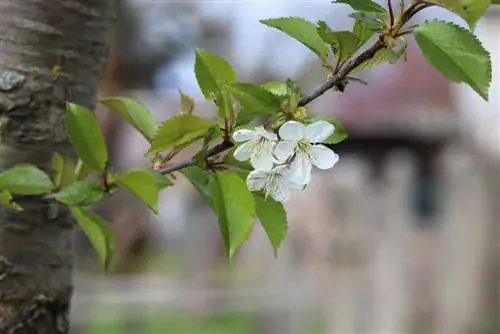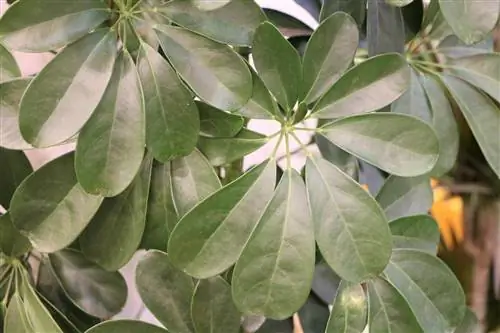- Author admin [email protected].
- Public 2023-12-17 03:39.
- Last modified 2025-01-24 12:45.
The bird cherry is particularly popular in natural gardens, as it is a pasture for bees during its long flowering period and as a tree with valuable fruits for birds during the harvest season.
Profile
- bot. Name Prunus padus
- Rosaceae family
- other names swamp or awl cherry
- white flower clusters from April to June
- Growth type Large shrub or small tree
- multi-stemmed and overhanging
- up to 15 meters high and 8 meters wide
-
sensitive to limescale
Poisonous plant for children, horses and other animals
- Confusion with highly poisonous American bird cherry (Prunus serotina)
Flowering time and flowers
From April to June, the long flower clusters form on Prunus Padus, with up to thirty white flowers hanging on each cluster, which look very decorative, but also offer both disadvantages and advantages:
- strong to unpleasant smell
- ideally not plant near a seat
- rich in nectar and pollen
- attract bees, butterflies and hoverflies
Note:
The bird cherry owes its name to its flower clusters and the cherry-like stone fruits that later form.
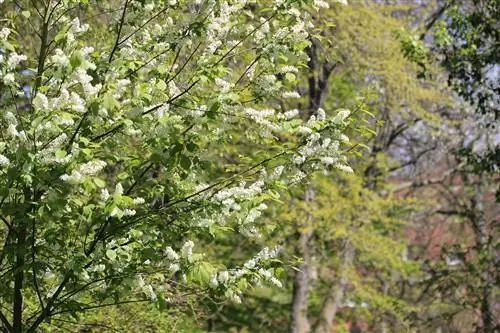
Soil conditions and location
In its natural environment, Prunus padus grows on the edges of water bodies, on the edge of forests and in sparse riparian forests. In the garden, the plant can be cultivated either as a solitary plant or with enough distance in a hedge:
- low light requirement
- Penal shade or even shade desired
- preferably near water
- Soil should be moist and fresh
- nutrient-rich
- enrich with compost before planting
- Swamp soil such as loam or clay is ideal
- limescaletolerant
- Avoid drought
Tip:
The reason why the wide shrub is so suitable for colorful hedge cultivation is because it not only provides the birds with food, but also enough space and peace to build their nests.
Fertilizing and watering
Bird cherries have a very high water requirement. Therefore, they need to be watered regularly and a lot, especially on very hot days:
- Soil well
- ideally in the early morning or late evening hours
- water daily in dry times
- Use rainwater due to lime intolerance
- Tap water must be stale
- Fertilizing once in spring is enough
- Fix compost and horn shavings
- alternatively give long-term fertilizer such as blue grain
- Regular mulching helps prevent moisture loss and fertilizes at the same time
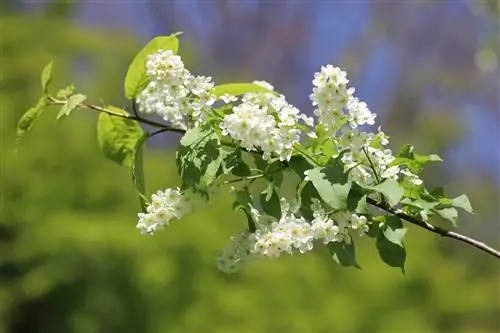
Harvest time
The black cherry produces red and then black drupes in September, which are very popular with birds. Since the fruits are not poisonous and are actually edible, they can also be used in the kitchen:
- bittersweet to bitter taste
- can be processed
- suitable for juice, jelly or vinegar
- Caution star core is slightly poisonous
- contains a small amount of hydrogen cyanide
Note:
Birds can distribute the seeds in the garden and the wider area, causing Prunus padus to multiply unintentionally.
Toxicity
If there are small children or horses in the garden, you should avoid cultivating the bird cherry. The poisonous parts taste so unpleasant for both children and animals that they are usually spit out immediately. However, caution should be exercised:
- bitter sour aroma
- in bark and all other parts of plants
- poisonous hydrogen cyanide glycoside
- decomposes in combination with water to form bitter almond oil and hydrogen cyanide
- kernels are also poisonous
- contains prussic acid like apricot kernels
- should not be swallowed with the non-toxic fruits
More dangerous in terms of confusion is the American bird cherry (Prunus serotina), which, in contrast to the native plant here, is not cultivated and is rather fought. This type of bird cherry releases highly toxic hydrogen cyanide from all parts of the plant and consumption can lead to symptoms of poisoning; it is not uncommon for the two varieties to be confused.
Tip:
Nevertheless, you don't have to worry too much about your children or animals if you have cultivated Prunus padus in the garden. Because the seeds in the fruits are so large that they are usually not accidentally swallowed.
Diseases and pests
Even if the bird cherry is considered to be quite robust, it is not completely spared from pests and diseases. This means that a tree can be completely engulfed by the web moth. The larvae feed on the leaves and can almost eat the plant bare. However, Prunus padus recovers from this quite quickly and sprouts again. In addition, the birds are happy about the food source, so this problem usually solves itself. There are other diseases and pests that can affect the crop:
- scab
- Leaf spot disease
- Brown rot
- all fungal diseases
- take action against this with fungicides
- remove all infected twigs and branches
- Aphids and fruit flies
- spray with hard water jet
- several days in a row
Tip:
So that the plant is better protected against diseases and pest infestation, care errors should be avoided. These include an incorrect dark location, too dry but also waterlogging as well as a calcareous and too heavy soil.
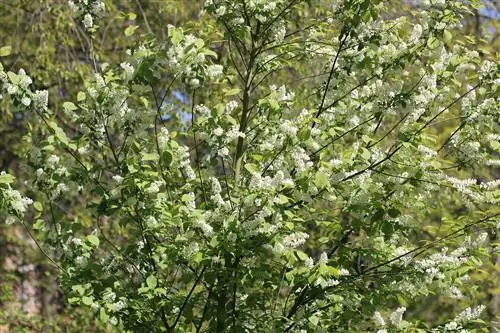
Plants
It is ideal if the shrub is planted in autumn. Here it is important to stop the very sprawling plant and to create a root barrier so that it cannot spread underground. To do this, a dense mesh must be used around the root ball so that the roots cannot penetrate:
- Prepare soil with compost and horn shavings
- Planting hole twice as large as root ball
- Dip the bale completely into water
- drainage is not necessary
- Insert support for young plants
- Insert plant
- Fill in soil
- press well
- pour on
Tip:
If you create a hedge with several plants, make sure there is enough distance now. Prunus padus also grows in width, so that opaque hedges can quickly be created even with a larger planting distance. You should maintain a planting distance of one to two meters here.
Cutting
Pruning the bird cherry is essential because the shrub grows expansively and quickly. The most important thing here is to pay attention to the right time. Just once a year is by no means enough to keep the bird cherry small, as it grows almost 80 centimeters in a year. Depending on whether it is a hedge plant or a solitary plant, the cutting procedure must be carried out accordingly:
- cut in late winter between February and March
- choose a frost-free, dry and overcast day
- a second time in autumn
- Cut hedge height
- Thinning out a tree or shrub
- removing damaged and dead wood
- also vertically growing or crossing shoots
- Cut the crown of a tree into an appropriate shape
- always cut diagonally above an outward-facing eye
- always use sharp and clean tools
If the crown of a Prunus padus growing as a tree is permeable and even after cutting, then this is completely sufficient. The hedge is also slightly permeable again after cutting, but will grow back opaque again in a short time.
Note:
If no root barrier has been set up, you must also remove the lateral root runners when cutting regularly. Do not add these to the compost, otherwise new bird cherries could grow from them. It is better to dispose of the roots in the residual waste.
Wintering
The older bird cherry plants survive the winter, even if it is very cold, without any protection, but a layer of mulch can be placed around the trunk above the roots. However, the young, newly cultivated plants should be protected from severe frost in the first winter:
- Place brushwood or leaves over root ball on soil
- Cover the crown with plant fleece
- Cover newly created hedges with plant fleece
- don’t forget to water even in winter
- water on frost-free days in dry periods
Note:
In a winter, Prunus padus is more likely to dry out if there is no rain for a long time than for the plant to die from frost damage.
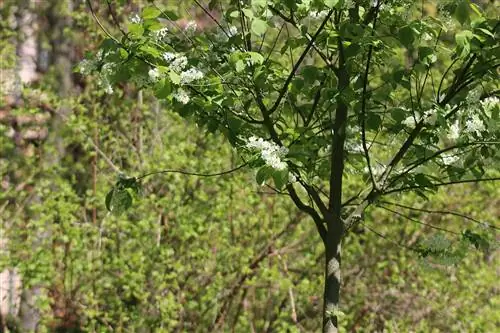
Propagate
Propagating bird cherries is easy using cuttings. This type of propagation is particularly useful if the plants are to form a hedge. The fast-growing shrubs can form a dense hedge with cuttings within a short period of two to three years. But a solitaire can also be grown from cuttings:
- Use cuttings
- these are hard shoots
- cut between autumn and winter
- Use shoots that are about 40 centimeters long
- three leaf nodes on each cutting wood make sense
- put in pots with potting soil
- a leaf node underground
- place in a bright, warm place
- Window sill or greenhouse is ideal
- keep moist
Once rooting has taken place, the small young plants can be planted directly outdoors at the desired location in spring. Alternatively, cuttings with leaves can be used in spring and grown in the same way. When the first new leaves appear, they are also planted outdoors.
Note:
The day you cut the cuttings, it should be frost-free, dry and covered. Then the interfaces on the plant can best heal again and close without the plant itself being damaged.


